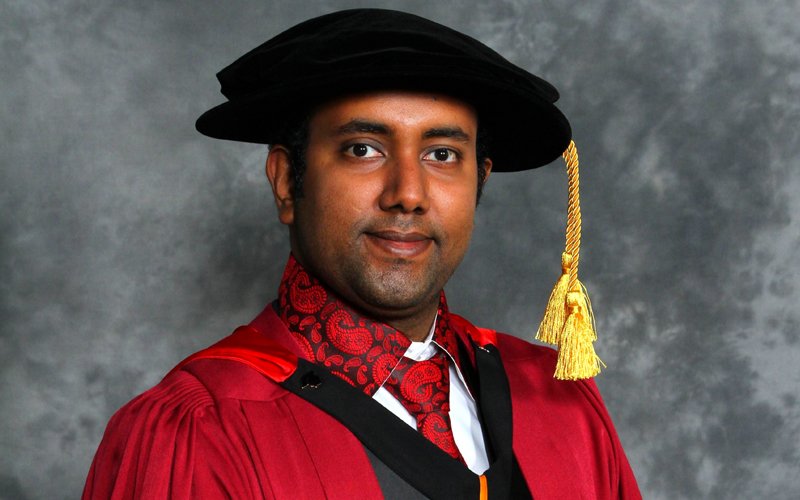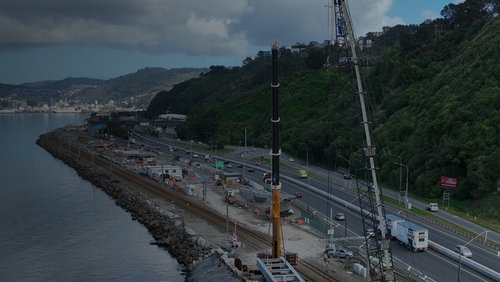12 Jun 2025
Auckland University of Technology's Sadeesh Silva answers a few questions about his passion for engineering, his take on AI in engineering and how his career has taken him all around the world.
Tell us about your role at AUT?
I joined the Department of Electrical and Electronic Engineering at Auckland University of Technology (AUT) early this year, following my role as a postdoctoral research engineer at the University of Canterbury (UC) since January 2022. As a passionate researcher in Power Electronics and Renewable Energy, I have been involved with various research projects and teaching activities at UC and University of Waikato, where I completed my PhD studies in 2021. I got the opportunity to pursue in an academic career in New Zealand at AUT as a lecturer, where I currently teach Power Electronics and Sustainable Energy courses to undergraduates. My teaching role involves designing and delivering courses in sustainable energy applications such as solar, wind, hydrogen fuel cells, electric vehicles as well as related power electronic converter systems. Also, my research focuses on developing energy efficient supercapacitor-based power electronic circuits for promoting sustainable solutions to achieve decarbonisation goals. This, I believe will contribute towards New Zealand’s energy transition to net-zero in the future.
Who or what inspired you to work in the field of engineering?
Well, this question has several answers. First of all, I owe a great debt of gratitude to my parents for providing me with a good education. During my university days, I was fascinated by the theories of great scientists like Isaac Newton, Albert Einstein and Stephen Hawking, therefore decided to complete my first degree majoring in Physics and Electronics. My direct transition to Engineering initiated as I met Professor Nihal Kularatna in 2016 at a workshop held in University of Kelaniya. After talking to him, I was inspired to come to New Zealand to pursue a PhD in Engineering, where I researched on a patented supercapacitor-assisted surge protection technique called SCASA with Prof. Kularatna. During my doctoral studies, I developed a permeance-based model to explain the operational modes of SCASA transformer and carried out frequency-domain validations using Laplace transforms. I also designed high performance circuit prototypes using low-cost magnetic materials to enhance surge absorption of the existing technique. In addition, I would like to express my sincere gratitude to Professor Alistair Steyn-Ross, my second supervisor, for inspiring me to develop fine mathematical techniques to handle complex engineering problems.
I also want to thank Dr. Hamish Avery for his support on the project “EVSE and EV Charging Efficiency and OCPP Compliance Testing” of Fast DC Chargers and AC Home Chargers typically found in New Zealand. This was a timely project focused on New Zealand’s electrification goals and funded by the Energy Efficiency and Conservation Authority (EECA) in New Zealand. This is by far one of best real-world engineering projects of my research life. I am also thankful to Professor Neville Watson for his mentorship and research guidance during my time at UC.
Where has your engineering career taken you around the world?
As an active member (SMIEEE) of the Institute of Electrical and Electronics Engineers (IEEE), I have attended various IEEE conferences and symposia around the world. In 2019, I was a recipient of the IEEE Young Professionals Award at the 28th ISIE conference held in Vancouver, Canada. In addition, my research contributions have been presented and published in several other conferences held in Australia, Italy and USA. I have also had the opportunity and pleasure of visiting other parts of the world to countries such as Singapore, Hong Kong and India.

Sadeesh Silva. Photo: supplied
Tell us about your work with electric vehicles (EV) and EV chargers and what is your view on electric cars?
I think Electric Vehicles (EV) are a game-changer for the Automotive Industry. With zero carbon emissions and superior efficiency levels over fuel-powered vehicles, EVs offer a wide range of benefits for the consumers such as low running costs as well as maintenance costs. Regarding my previous work relating to EVs and EV chargers, I was involved in a EECA funded project during my postdoc time at the University of Canterbury. During this project, we investigated efficiency performances of fast DC chargers (Phihong-60/30, Tritium-50, Delta-25) and AC home chargers (Siemens, Etrel, Evnex, ABB) commonly used in New Zealand. In addition, this project also covered a study of EV charging internal efficiencies testing typical EVs such as Tesla model-3, BMW i3, Hyundai Ioniq and Nissan Leaf. Based on these experiences, I will continue to research on EVs and EV charger technologies with a special focus on EV battery thermal management and EVSE generated harmonics.
Looking at the rapid growth of New Zealand’s EV fleet over the past several years (since 2017), I think transitioning to 2050 net-zero targets is strongly supported by the adoption of electric vehicles. Also, with ever advancing battery technologies and high-efficient EV charger deployment, electric vehicles will continue to blossom in New Zealand providing a great convenience and affordability to Kiwis.
Do you encourage your students to use AI and if so, what guidance do you give them?
AI is a technology that is highly influential and has transformed every walk of life over past several years. As with every other technology, AI has its own benefits and drawbacks. When it comes to university education, I encourage my students to use AI-based tools with software packages such as MATLAB, Simulink and LTspice to model and analyse engineering problems. These tools facilitate creating interactive interfaces to model and simulate real-world applications such as solar farms, wind turbines and various other renewable energy-based power electronic systems. Apart from learning theoretical knowledge in class, our students can visualise real-world engineering problems and obtain a solid understanding of the fundamental concepts with the help of such AI-powered tools.
That being said, I never encourage students to apply AI tools for their research writing or to analyse engineering problems that require creative thinking. I personally believe AI lacks the ability of emotional intelligence and human creativity when it comes to seeking novel solutions for inventive problems. AI systems, despite their impressive capabilities, can never fully replace human creativity and innovation.
Why are you a member of Engineering New Zealand?
Well, I think being part of Engineering New Zealand provides me several key benefits. First of all, Engineering New Zealand is a great professional organisation, where I can build my connections with the academics and industry professionals from various institutions within New Zealand. Through different events, technical groups and other engagement activities, I aim to grow my professional network, to promote industry-academia collaborations. This, I believe is a key step in translating our research into the commercial world. Moreover, Engineering New Zealand encourage their members through various fellowship programs and award schemes providing career advancement opportunities for their members.
If you could collaborate with any engineer in the world, who would it be and why?
I would love to meet Professor Frede Blaabjerg, a world-renowned academic in Power Electronics from Aalborg University, Denmark. As a pioneer in the field, he has inspired many young engineers around the world to research on different aspects of power electronics through his impactful books and research papers. Despite being connected on LinkedIn, I have never met him in-person. However, I hope to have the opportunity of meeting him one day at a conference or similar research event. Also, if there’s opportunity, I would love to collaborate with him on a research project in the future.
What is your favourite piece of engineering in Auckland?
As a researcher who supports decarbonisation paths in transport sector, I think Auckland railway electrification is my favourite engineering project in Auckland. This major transport infrastructure project will bring substantial benefits to the Auckland communities including shorter travel times, improving the resilience, capacity and efficiency of the rail network as well as reducing carbon emissions to enhance sustainability goals in reaching a net-zero future. I am keen on getting involved in such mission-electric projects in Auckland to turn our fleet of buses, trains and ferries electric with the hope for a brighter emission-free future.







